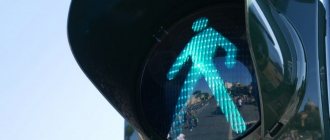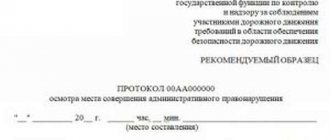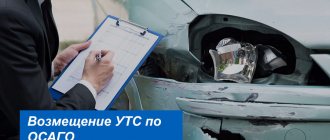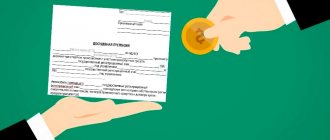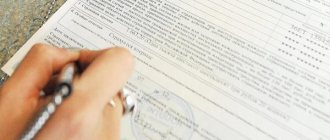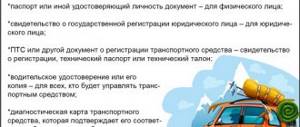What is a recourse claim?
A recourse claim is the right of a person who has paid for damage caused by another person to demand financial compensation for his expenses from the culprit. Recourse in compulsory motor liability insurance is the right of the insurance company to recover from the culprit of the road accident compensation for the costs of paying compensation to the injured party .
This right is enshrined in Art. 14 of the Federal Law of April 25, 2002. No. 40-FZ. From May 1, 2019 This article has undergone significant changes, which affected cases of possible appeal to the court.
The insurance company will be able to make recourse claims after actual compensation for damage to the injured party and only through the court .
When does the insurance company have the right to go to court?
The insurance company has the right to recover compensation for expenses incurred from the at-fault motorist if he:
- deliberately caused harm to the life or health of the victim;
- drove a car while intoxicated;
- refused to undergo a medical examination;
- fled the scene of a car accident;
- not specified in the MTPL policy;
- drove the car within the period not provided for in the insurance contract;
- independently repaired or disposed of a damaged vehicle without first submitting it for an independent examination;
- had an expired diagnostic card;
- when concluding an insurance contract, provided false information, which resulted in an underestimation of the insurance premium;
- drove a car with a trailer, provided that the insurance does not cover driving a car with a trailer.
Until May 1, 2021, the insurance company had one more reason to file recourse claims. It provided for the possibility of recovering expenses from the culprit recorded under the European Protocol if the culprit did not send a completed protocol to the insurer within 5 business days after the incident.
Article 2 of the Federal Law of 01.05.19 No. 88-FZ, paragraph Zh was repealed . Now there will be no recourse under the European Protocol, even if the guilty party did not send a timely notification to the Investigative Committee.
What happened?
The obligations of drivers under compulsory motor liability insurance are regulated by the corresponding Federal Law of the same name FZ-40. It was he who previously had the following provisions in 2 of his points:
- paragraph 2 of article 11 obligated both participants in the accident in the case of the European protocol to send notification forms to their insurance companies within 5 days,
- pp. “g” of paragraph 1 of Article 14 prescribed that in the event of failure to fulfill the above obligation by the culprit, the insurer had the right to issue him a recourse for the amount of compensation to the injured person.
1. The right of claim of the victim against the person who caused the harm is transferred to the insurer who has provided the insurance compensation in the amount of the insurance compensation provided to the victim, if:
…. g) the specified person, in the case of processing documents about a road traffic accident without the participation of authorized police officers, did not send to the insurer that insured his civil liability a copy of the notification form about a road traffic accident completed together with the victim within five working days from the date of the road traffic accident transport accident;
On May 1, 2021, the corresponding Federal Law No. 88-FZ was issued, which amended the above legal act. To be more precise, there are 2 changes:
- subparagraph “g” is declared invalid,
- a recourse claim cannot now be brought against a pedestrian in cases where harm is caused to his health, as well as against his relatives if the pedestrian is killed (Article 5 of Federal Law No. 88).
Thus, as of May 20, 2021, the obligation of both participants in the accident to send their copy of the European Protocol notice each to their insurance remained. However, there will be no consequences for failure to fulfill such an obligation: no recourse, no fine, no other liability.
How to avoid payments
The insurance company can make recourse claims either in case of violation of traffic rules or in case of violation of the terms of the insurance contract. To avoid recourse under OSAGO:
- do not drive a vehicle while intoxicated;
- monitor the validity of technical inspection and insurance;
- do not leave the scene of the accident;
- follow the traffic rules.
The insurance company has 15 days to conduct an examination of the vehicle. Failure to present a vehicle for inspection is also grounds for filing a lawsuit. Therefore, show the car to the IC upon request and do not repair the damage until the examination is completed.
What to do after an accident
To avoid giving the insurance company a reason to forcefully collect funds under the Euro Protocol, follow the instructions:
- stop;
- install a warning triangle;
- record an accident using photos and videos;
- write down contact details of witnesses, if any;
- fill out the Europrotocol and only then leave the scene of the incident.
It is possible to register a car accident without calling traffic police officers only if three conditions are met simultaneously:
- car owners have an MTPL policy;
- no dead or injured;
- no damage is caused to third parties.
Immediately notify the insurance company by phone about the incident. Submit documents for payment of compensation within 5 days from the date of the accident . But even if the allotted deadline is missed, the Investigative Committee cannot refuse to accept documents.
What is the most common reason for recourse under the European Protocol?
Most often, an insurance company demands compensation for damage under compulsory motor liability insurance with the European Protocol for the following reasons:
- if the driver filled out the notice, but did not manage to submit it to the insurance company within five days after the traffic accident;
- if, within the next 15 days after the accident, the driver at fault began repairing the car or disposing of it;
- if the insurance company's requirement to provide the car for inspection within 5 working days has not been satisfied.
Neglect of these very rules allows the insurer to demand recourse from the person who caused the accident.
Related article: Rules for payment for an insured event under MTPL
The culprit did not send notification of the accident to the insurer on time
If the culprit of the accident does not have time to inform the insurance company about the accident within 5 working days, then he will compensate the damage to the other driver himself. If the Europrotocol is chosen to document the accident, then after filling it out, in accordance with subparagraph “g” of Art. 14 of the Federal Law “On Compulsory Motor Liability Insurance” and the rules of Compulsory Motor Liability Insurance, the person responsible for the accident can personally visit the insurance office and give them a notification. You can also send a personal copy by fax or registered mail.
Some insurance companies do not use the most honest and humane methods in their work, so that compensation for damage falls on the shoulders of the person responsible for the accident. They take advantage of people's inexperience and ignorance of the laws. For example, if the driver filled out the Europrotocol on time, the culprit submits a notice to the insurance company within a 5-day period, specialists take a copy of the document, and return the original to the driver. In this case, it will be considered that the car owner did not send the Europrotocol and did not notify his insurance company.
Insurance firms may also use other methods to relieve themselves of financial liability, including:
- refusal to accept documents for biased reasons;
- they do not always mark the acceptance of documentation, as a result of which very often these documents are lost in the future;
- if the document was sent as a file via the Internet or by mail, representatives of the organization may say that the letter was empty or that they did not receive it at all.
Important! Even if all participants in the accident have insurance services provided by the same company, the person responsible for the accident must personally notify it of the incident, providing his own copy within the allotted time.
Failure to provide a vehicle for inspection
Each participant in an accident, according to the Federal Law “On Compulsory Motor Liability Insurance”, must provide his own car for inspection within five days, if required by the insurance company. This period may be changed if mutual agreement is reached between the parties. The insurance company sends this requirement to each client by mail.
Repair or disposal of damaged vehicle within 15 days
According to the law “On Compulsory Motor Liability Insurance”, the driver at fault for the accident does not have the right to restore the condition of his car earlier than within fifteen days from the date of the incident. If he violates this condition established by law, he will compensate the insurance company for the amount that it paid to the injured party. This rule applies not only to the culprit of the accident, but also to the rest of its participants.
You can carry out repairs and modernization yourself 15 days after a traffic accident. If the driver has MTPL insurance, then it is better to wait for the official examination. If the insurance agent is in no hurry to notify the client about the upcoming inspection, then you can contact independent organizations to assess the condition of the car. In this case, the driver will have insurance in case any of the other parties decide to dispute this point.
Related article: Compulsory civil liability insurance
How to fill out the Europrotocol
To obtain insurance, fill out the form correctly and submit a notification to the insurance company. The Europrotocol is filled out on a special form issued by the insurance company. If it is not available, download the document on the Internet, on the insurance company’s website. Indicate in it:
- date and place of the accident;
- information about car damage;
- data from witnesses of the accident;
- number and date of the MTPL policy;
- information about the persons driving the vehicles.
Draw up a diagram of the accident. It should be clear and not raise additional questions. All designations must have an explanation.
On the back of the form, the participants in the accident describe their vision of what happened, and also enter additional information, for example, about the presence of video recording.
Rules for filling out a notification of an accident
By concluding a contract for an MTPL policy, each car owner receives 2 sets of stapled double-sided Road Accident Notification forms. The law does not require you to carry it in the car, however, it is advisable that you always have it with you. If for some reason there is no notification of an accident, you must contact your insurance agent and obtain this form from him.
When starting to fill out, please note that this paper consists of a front and back side, and the paper on which notices are issued is self-copying.
All information that is entered on the front side must be clearly imprinted on the bottom sheet, so a regular ballpoint pen is required to fill it out, since a gel or capillary pen can easily smudge, and what is written with a pencil can easily be erased.
The notification form is divided into two columns (A and B), in each of which drivers fill out information about the accident. The law stipulates that all lines and sheets must be either filled in with information or filled with dashes.
In the event of a traffic accident, it does not matter which driver provides the Europrotocol form.
Filling out the front side of the form
The notification of an accident, or rather its front part, contains fields in which it is necessary to indicate the place, time, date of the accident, as well as information about the participants and witnesses.
It should also include information about the insurance company with which the MTPL agreement was concluded, the nature of the damage to the victim’s car, circumstances and other important information.
Particular attention is required when filling out clause 14. Here you need to indicate the nature and list of all damage to parts and elements of the injured driver’s car that are visible to the naked eye. They need to be described as accurately as possible.
Brevity here is not the sister of talent, therefore, if there is not enough space in the column, then you need to use additional lines (clause 15). If you are the culprit of the accident, make sure that the victim does not write down the damage that was there before the accident.
For example, in a rear collision, a dent was formed on the rear fender during the accident. Moreover, if the bumper was previously damaged, then the victim will be strongly tempted to receive compensation for these damages at the expense of the culprit.
Also, when indicating the nature of damage to the car, it is necessary to use clear and generally accepted terminology - scratch, chip, deformation, rupture, crack.
Damage that cannot be seen immediately will be identified and described in the examination report, therefore, when filling out the notice, you should not draw conclusions about breakdowns in advance.
It is very important to follow generally accepted terminology when filling out paragraph 16, in which the circumstances of the road traffic incident should be noted. In the large cells located below, you should fill in the total number of marked items.
Also, it is imperative to correctly note the vehicle maneuvers that preceded the incident. For example, drivers often confuse the concepts of parking and stopping, as well as overtaking and getting ahead or changing lanes.
If the car stopped at a prohibitory traffic light or a STOP sign, and a collision occurred, then you must check item 22 (stopped at a red traffic light or a prohibitory road sign). If there was an accident while advancing, then it should not be confused with overtaking - these are completely different circumstances, consequences and responsibilities.
The notice contains a place to display a diagram of the accident. This is point 17.
The diagram of the traffic accident must indicate:
- names of streets or roads;
- direction of movement of vehicles;
- final position of the cars;
- road signs;
- signs;
- traffic lights;
- road markings;
- items that are related to the incident.
If it is necessary to add something or add it in more detail, drivers can use paragraph 15. Further, in paragraph 18, drivers put their signatures if full agreement is reached. Participants sign both sheets of the notice on the front side and after that they can unfasten the sheets of the Europrotocol form.
Filling out the back of the notice
Once the front side is completed, drivers can begin filling out the back side of the notice.
This is no longer done jointly, but by each participant separately. Additional information about this traffic accident, the technical condition of the vehicle, etc. is indicated here.
If there is not enough space on the back side to describe all the nuances and subtleties of what happened, you can attach a sheet of plain paper to your copy.
In this case, on the main form it is necessary to write about, and also indicate what this application refers to and who compiled it.
Additional Tips
If your traffic accident was recorded on a video recorder, then in paragraph 7 you can make a note about this and provide the insurance company with the video recording.
As a rule, such evidence and circumstances significantly speed up the review process and payment of compensation. It would also be useful to indicate in the notice the presence of witness statements, as well as contact details of eyewitnesses of the traffic accident.
Important! If the notice contains information and records written illegibly, with corrections and blots, such European protocols may be invalid.
Insurers are quite lazy, so they are unlikely to agree to collect the missing data. Therefore, if you want to receive compensation as quickly as possible, then fill out the notice in block letters, do not rush, do not be nervous and do not make mistakes.
What to do in the event of a recourse claim
After receiving notification of the opening of legal proceedings on the claim of the insurance company, do not rush to enter into a settlement agreement and pay recourse under the European Protocol. This can be done at any stage of the trial.
To obtain compensation from the person responsible for the accident, the insurance company must prove:
- the fact of transfer of money to the injured party;
- the presence of legal grounds for recovery by way of recourse under compulsory motor liability insurance.
Evidence of legal grounds for recourse claims must be documented. For example, if the Investigative Committee refers to the hiding of the guilty person from the scene of the accident, then it must have in its hands a court decision that has entered into legal force to hold the car owner liable for this offense.
In addition to insurance, the company has the right to recover from the person at fault for the accident:
- money spent on examinations;
- expenses for conducting insurance business;
- state fee for filing a claim.
All these costs will fall on the car owner, provided that the insurer proves that he is right.
A motorist against whom legal proceedings are underway to reimburse the insurer’s costs can avoid recourse if he proves that the insurance company’s arguments are unfounded. To do this, involve an experienced lawyer in the trial and file a counterclaim alleging unlawful actions of the insurance company.
Evidence of innocence will be:
- photo and video materials;
- witness's testimonies;
- documents from the accident site.
Even after a court decision is made in favor of the insurance company, do not rush to pay the claim. According to the law, the parties have 30 days before it comes into force.
What should the culprit of an accident do after drawing up the Europrotocol?
Sometimes an accident commissioner may be present when registering an accident. If possible, he will try to collect the notice from all car owners in order to forward them to the insurance company. In general, this is quite normal. But sometimes, after such a notification, the person at fault for the accident receives recourse under the European Protocol. This happens due to the fact that emergency commissioners may be employees of insurance organizations. Therefore, all their actions will be aimed at satisfying the interests of the insurance company.
There is also no guarantee that the emergency commissioner will deliver the documents to their destination in the required time frame and will not lose them. In any case, it will be very difficult to prove the driver is right; he will have to compensate for the damage, as judicial practice shows.
Therefore, you should not immediately trust the emergency commissioner, since after such cooperation it can be very difficult to avoid recourse. But there are options for safe communication with the emergency commissioner:
- you need to give him the documentation in front of third parties;
- You can create photos and videos as evidence, they are not prohibited;
- You can ask the commissioner to issue a receipt.
How to submit a notice correctly
Every responsible driver knows how not to pay recourse under the European Protocol. Therefore, most of them will try to take a correctly completed form to the insurance company’s office in person.
When submitting the notice, the insurance representative writes on the copy:
- seal;
- incoming number;
- date of acceptance of the document;
- details of the receiving party (initials and position).
This will guarantee that the Europrotocol was submitted to the insurance company so that the company does not sue.
Drivers can also use the service of sending the Europrotocol by mail; it can be sent to the Investigative Committee by registered mail with acknowledgment of receipt, and it is also mandatory to make an inventory of the attachment. You can find the postal address of your insurance company in your MTPL policy. Until the completion of the proceedings, you need to keep all documents, papers and receipts from the insurer; the inventory of the attachment will serve as confirmation that you have provided the insurance company with all the necessary documentation.
Auto examination
Car inspection is a prerequisite in the event of an insured event. The length of the assessment will depend on the complexity of the study and many other factors. The expert study usually lasts up to 10 days. The duration of a forensic examination can be 3 times longer – up to 1 month.
Related article: What does the new law on electronic compulsory motor liability insurance mean?
How to reduce the amount of compensation
If the guilty party failed to challenge the claim and the court ordered compensation to be paid to the insurer, then the amount of compensation can be reduced. This will be much easier to do if you take a direct part in inspecting the damage to the damaged vehicle.
Compare the amount indicated in the statement of claim with the amount of actual payment to the injured party. To do this, ask the injured party for a document about the amount of funds received from the insurance company. Submit the received papers to the judge for review.
How else to reduce the amount:
- order an independent assessment of car damage;
- check the list of damages specified in the Europrotocol with the list of repair work performed at a car service center, if instead of paying money to the victim, the car was repaired.
If it is not possible to reduce the amount, then apply for an installment plan. The court must draw up a schedule of payments in favor of the insurance company, taking into account the financial situation of the guilty person.
Arbitrage practice
Cancellation of recourse under compulsory motor liability insurance from May 1, 2021. in case of untimely notification, the insurance company is designed to reduce the number of cases regarding reimbursement of funds by the insurer in the courts. Previously, most insurance companies did not intend to accept notifications from motorists in order to subsequently collect insurance payments from them. But even after the abolition of clause G, insurers have sufficiently compelling grounds to file recourse claims.
Judicial practice on the basis of untimely notification of the insurer is ambiguous. Most decisions were made in favor of the UK. Therefore, the abolition of this basis has made life easier for motorists.
Summary
To avoid paying recourse to the insurance company, remember:
- the insurer can recover compensation only in court;
- recovery is possible only on the grounds listed in Art. 14 of Law No. 40-FZ;
- the statute of limitations for recourse to compulsory motor liability insurance is 3 years from the date of payment to the victim;
- during the trial, try to reduce the amount of compensation;
- agree on installment payments to the insurance company;
- failure to provide notification of an accident within five days in relation to accidents committed after 05/01/19 is not a basis for filing recourse claims;
- all the insurer’s arguments must have documentary evidence;
- During legal proceedings, use the assistance of a lawyer.
More…
- What to do if the person at fault for an accident does not have compulsory motor insurance
- What documents are needed to file an insurance claim under MTPL?
- An example of filling out a notification of an accident under MTPL
- Is the culprit of the accident paid insurance under compulsory motor liability insurance?
How to fight off insurance claims
Let's look at how to avoid claims if the insurance company has issued a recourse under the European Protocol. Initial precautions must be taken into account when drawing up a notification at the accident site:
- according to the European Protocol, traffic police officers are not called, a protocol is not drawn up under the Code of Administrative Offenses of the Russian Federation, so your guilt must be indicated in the most vague terms;
- the second copy of the document must be obtained at the scene of the accident, and then submitted along with the car to the insurance company (this must be done within 15 days after the accident);
- You need to repair the car only after making sure that the insurer has accepted the notice, or you have a receipt in your hands indicating that it was sent.
Although according to Art. 14 of Law No. 40-FZ can only refer to failure to provide a car for inspection, you are still obliged to notify the insurer about the fact of the accident. To avoid unnecessary problems, submit a notification immediately after an accident, or along with the car during inspection.
If the insurer sees grounds for recourse, it must send you a claim and indicate the calculation of the compensation that the victim will receive. You have the right to file an objection to the claim or wait for a trial. We recommend that you do not pay the insurance company only on the basis of a claim, but immediately seek legal advice.
As part of the legal process, you have the right to file objections to the recourse claim, study the materials of the insurance case under the European Protocol, and challenge the calculation of losses under the compulsory motor liability insurance. If the decision is not made in your favor, you can file a complaint to appeal, cassation and supervision. If you contact a lawyer in a timely manner, you have a good chance of winning your case or successfully appealing the court verdict.
Find out more I left the scene of an accident and how to resolve the issue
